The Aircraft Cooling Turbines Market is estimated to be valued at USD 1.5 billion in 2025 and is projected to reach USD 3.1 billion by 2035, registering a compound annual growth rate (CAGR) of 7.5% over the forecast period.
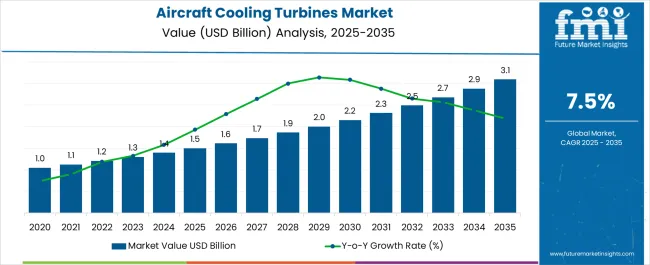
| Metric | Value |
|---|---|
| Aircraft Cooling Turbines Market Estimated Value in (2025 E) | USD 1.5 billion |
| Aircraft Cooling Turbines Market Forecast Value in (2035 F) | USD 3.1 billion |
| Forecast CAGR (2025 to 2035) | 7.5% |
The Aircraft Cooling Turbines market is experiencing steady growth driven by increasing demand for efficient thermal management systems in modern aviation. Growth is being influenced by the rising number of commercial and wide body aircraft operations, which require advanced cooling solutions to maintain optimal engine performance, passenger comfort, and system reliability. The market expansion is supported by the adoption of energy-efficient cooling technologies that improve fuel economy and reduce environmental impact.
The ongoing modernization of aircraft fleets, coupled with rising air travel demand in both developed and emerging economies, is enhancing the need for advanced cooling turbines. Additionally, investments in research and development have improved turbine efficiency, durability, and adaptability to different aircraft types.
The market is further propelled by stringent aviation regulations regarding engine safety and operational efficiency As airlines focus on reducing maintenance costs and enhancing passenger experience, the demand for innovative and reliable aircraft cooling turbines is expected to continue its upward trajectory, creating substantial growth opportunities for manufacturers and suppliers in the coming decade.
The aircraft cooling turbines market is segmented by aircraft type, end use, and geographic regions. By aircraft type, aircraft cooling turbines market is divided into Wide Body Aircrafts and Narrow Body Aircrafts. In terms of end use, aircraft cooling turbines market is classified into Commercial, Transportation Aircrafts, Business Jets, Military, Transport Aircrafts, and Fighter Jets. Regionally, the aircraft cooling turbines industry is classified into North America, Latin America, Western Europe, Eastern Europe, Balkan & Baltic Countries, Russia & Belarus, Central Asia, East Asia, South Asia & Pacific, and the Middle East & Africa.
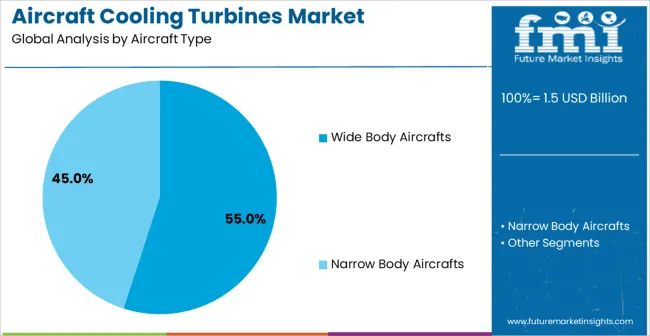
The wide body aircraft segment is projected to hold 55.00% of the Aircraft Cooling Turbines market revenue share in 2025, making it the leading aircraft type. This leadership is being attributed to the higher cooling demands of wide body aircraft, which accommodate larger engines, longer flight ranges, and more onboard systems compared with narrow body aircraft. Cooling turbines in this segment are increasingly being designed for enhanced thermal efficiency and reduced weight to optimize fuel consumption while ensuring consistent engine performance during extended flights.
The growth of this segment has also been reinforced by the expansion of international air travel, particularly in intercontinental routes where wide body aircraft dominate. Additionally, airlines are prioritizing fleet upgrades with modern aircraft that incorporate advanced cooling technologies to meet stringent emission standards and reduce operational costs.
The adaptability of turbines to meet diverse engine and environmental requirements has further fueled adoption in this segment Consequently, wide body aircraft continue to drive the market, reflecting both current demand and future growth potential.
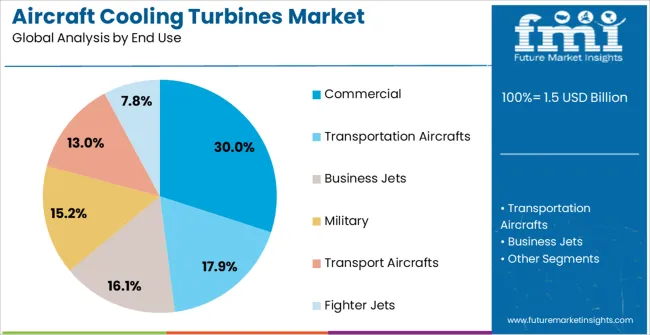
The commercial end-use segment is expected to account for 30.00% of the Aircraft Cooling Turbines market revenue in 2025, establishing it as the largest end-use category. This dominance is being driven by the increasing fleet size of commercial airlines and the rising passenger traffic, which necessitate reliable and efficient cooling systems to maintain engine and system performance.
The deployment of aircraft cooling turbines in commercial operations has been accelerated due to the need for energy-efficient solutions that can reduce fuel consumption and lower operational costs while ensuring passenger safety and comfort. The segment’s growth has been reinforced by technological advancements in turbine design, which allow integration with both new and retrofitted aircraft engines without compromising performance.
Maintenance efficiency and long service life are also key factors supporting adoption, particularly in large-scale airline operations where downtime can significantly impact profitability With ongoing growth in global air travel and the modernization of commercial fleets, the demand for aircraft cooling turbines in this end-use segment is anticipated to remain strong, offering consistent opportunities for market expansion.
An aircraft cooling turbine is an integral part of an air cycle system. The introduction of high-speed passenger aircraft and jet aircraft has introduced the need for compact and simple refrigeration systems. Aircraft cooling turbines have high capacity, with minimum payload.
When the requirement for refrigeration is high, air cycle systems usually prove to be the most efficient systems. In air cycle systems, aircraft cooling turbines are used to expand and cool air to supply it to the cabin.
Air cycle systems are generally used in pressurized gas turbine powered aircrafts. An aircraft generally has two or three air cycle systems. Aircraft cooling turbines can differ in size and number according to the aircraft size such as wide-body aircrafts and narrow body aircrafts. Additionally, aircraft cooling turbines are used in commercial and military aircrafts.
However, other refrigeration technologies for aircraft refrigeration systems use phase-changing materials for cooling such as Freon in a gas cycle, and do not require any aircraft cooling turbines.
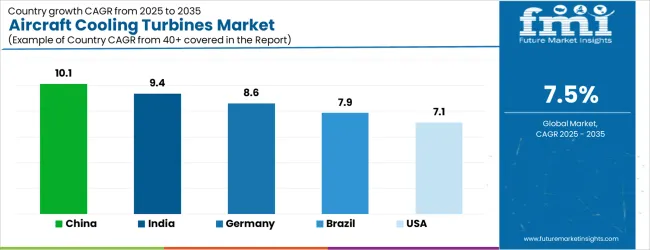
| Country | CAGR |
|---|---|
| China | 10.1% |
| India | 9.4% |
| Germany | 8.6% |
| Brazil | 7.9% |
| USA | 7.1% |
| UK | 6.4% |
| Japan | 5.6% |
The Aircraft Cooling Turbines Market is expected to register a CAGR of 7.5% during the forecast period, exhibiting varied country level momentum. China leads with the highest CAGR of 10.1%, followed by India at 9.4%. Developed markets such as Germany, France, and the UK continue to expand steadily, while the USA is likely to grow at consistent rates. Japan posts the lowest CAGR at 5.6%, yet still underscores a broadly positive trajectory for the global Aircraft Cooling Turbines Market. In 2024, Germany held a dominant revenue in the Western Europe market and is expected to grow with a CAGR of 8.6%. The USA Aircraft Cooling Turbines Market is estimated to be valued at USD 543.6 million in 2025 and is anticipated to reach a valuation of USD 543.6 million by 2035. Sales are projected to rise at a CAGR of 0.0% over the forecast period between 2025 and 2035. While Japan and South Korea markets are estimated to be valued at USD 80.5 million and USD 47.8 million respectively in 2025.
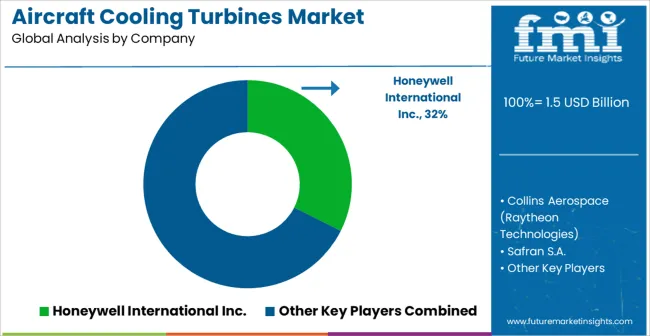
| Item | Value |
|---|---|
| Quantitative Units | USD 1.5 Billion |
| Aircraft Type | Wide Body Aircrafts and Narrow Body Aircrafts |
| End Use | Commercial, Transportation Aircrafts, Business Jets, Military, Transport Aircrafts, and Fighter Jets |
| Regions Covered | North America, Europe, Asia-Pacific, Latin America, Middle East & Africa |
| Country Covered | United States, Canada, Germany, France, United Kingdom, China, Japan, India, Brazil, South Africa |
| Key Companies Profiled | Honeywell International Inc., Collins Aerospace (Raytheon Technologies), Safran S.A., Rolls-Royce Holdings plc, MTU Aero Engines AG, United Technologies Corporation, Pratt & Whitney (Raytheon Technologies), and CFM International (GE & Safran JV) |
The global aircraft cooling turbines market is estimated to be valued at USD 1.5 billion in 2025.
The market size for the aircraft cooling turbines market is projected to reach USD 3.1 billion by 2035.
The aircraft cooling turbines market is expected to grow at a 7.5% CAGR between 2025 and 2035.
The key product types in aircraft cooling turbines market are wide body aircrafts and narrow body aircrafts.
In terms of end use, commercial segment to command 30.0% share in the aircraft cooling turbines market in 2025.






Our Research Products

The "Full Research Suite" delivers actionable market intel, deep dives on markets or technologies, so clients act faster, cut risk, and unlock growth.

The Leaderboard benchmarks and ranks top vendors, classifying them as Established Leaders, Leading Challengers, or Disruptors & Challengers.

Locates where complements amplify value and substitutes erode it, forecasting net impact by horizon

We deliver granular, decision-grade intel: market sizing, 5-year forecasts, pricing, adoption, usage, revenue, and operational KPIs—plus competitor tracking, regulation, and value chains—across 60 countries broadly.

Spot the shifts before they hit your P&L. We track inflection points, adoption curves, pricing moves, and ecosystem plays to show where demand is heading, why it is changing, and what to do next across high-growth markets and disruptive tech

Real-time reads of user behavior. We track shifting priorities, perceptions of today’s and next-gen services, and provider experience, then pace how fast tech moves from trial to adoption, blending buyer, consumer, and channel inputs with social signals (#WhySwitch, #UX).

Partner with our analyst team to build a custom report designed around your business priorities. From analysing market trends to assessing competitors or crafting bespoke datasets, we tailor insights to your needs.
Supplier Intelligence
Discovery & Profiling
Capacity & Footprint
Performance & Risk
Compliance & Governance
Commercial Readiness
Who Supplies Whom
Scorecards & Shortlists
Playbooks & Docs
Category Intelligence
Definition & Scope
Demand & Use Cases
Cost Drivers
Market Structure
Supply Chain Map
Trade & Policy
Operating Norms
Deliverables
Buyer Intelligence
Account Basics
Spend & Scope
Procurement Model
Vendor Requirements
Terms & Policies
Entry Strategy
Pain Points & Triggers
Outputs
Pricing Analysis
Benchmarks
Trends
Should-Cost
Indexation
Landed Cost
Commercial Terms
Deliverables
Brand Analysis
Positioning & Value Prop
Share & Presence
Customer Evidence
Go-to-Market
Digital & Reputation
Compliance & Trust
KPIs & Gaps
Outputs
Full Research Suite comprises of:
Market outlook & trends analysis
Interviews & case studies
Strategic recommendations
Vendor profiles & capabilities analysis
5-year forecasts
8 regions and 60+ country-level data splits
Market segment data splits
12 months of continuous data updates
DELIVERED AS:
PDF EXCEL ONLINE
Aircraft Cabin Environment Sensor Market Forecast and Outlook 2025 to 2035
Aircraft Flight Control System Market Size and Share Forecast Outlook 2025 to 2035
Aircraft Electric Motor Market Forecast Outlook 2025 to 2035
Cooling Tower Fans Market Size and Share Forecast Outlook 2025 to 2035
Aircraft Smoke Detection and Fire Extinguishing System Market Size and Share Forecast Outlook 2025 to 2035
Aircraft Hose Fittings Market Size and Share Forecast Outlook 2025 to 2035
Aircraft Cabin Interior Market Size and Share Forecast Outlook 2025 to 2035
Aircraft Galley Systems Market Size and Share Forecast Outlook 2025 to 2035
Aircraft Interior Lighting Market Size and Share Forecast Outlook 2025 to 2035
Aircraft Battery Market Size and Share Forecast Outlook 2025 to 2035
Cooling Skincare Gels Market Size and Share Forecast Outlook 2025 to 2035
Aircraft Floor Panels Market Size and Share Forecast Outlook 2025 to 2035
Aircraft Fuel Systems Market Size and Share Forecast Outlook 2025 to 2035
Aircraft Lubricant Market Size and Share Forecast Outlook 2025 to 2035
Aircraft Seat Market Size and Share Forecast Outlook 2025 to 2035
Aircraft Ground Support Equipment Market Size and Share Forecast Outlook 2025 to 2035
Aircraft Maintenance, Repair and Overhaul Market Size and Share Forecast Outlook 2025 to 2035
Cooling Laser Power Measurement Sphere Market Size and Share Forecast Outlook 2025 to 2035
Aircraft Actuators Market Size and Share Forecast Outlook 2025 to 2035
Aircraft Elevator Market Size and Share Forecast Outlook 2025 to 2035

Thank you!
You will receive an email from our Business Development Manager. Please be sure to check your SPAM/JUNK folder too.
Chat With
MaRIA